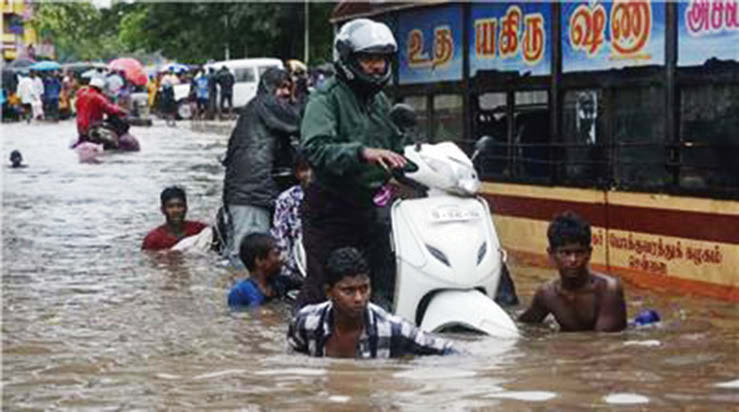
CHENNAI (TIP) While the world is talking about climate change. Delhi is smog laden; Chennai is flooded. Lakshadweep, Andamans, Kolkata, Mumbai may face annihilation, if earth’s temperature keeps rising at the pace it has been since industrial revolution.
The severe flooding in Chennai again questions India‘s preparedness for extreme weather events like rains, droughts and cyclonic storms which are becoming more frequent and intense.
Flooding in Chennai, the country’s fourth-largest city, has killed more than 40 people in the past 48 hours, authorities said Thursday, December 3, bringing the death toll to 260 since last month.
A large-scale rescue operation is under way, amid neck-high water in some areas as Chennai continues to bear the brunt of the deluge. Daily downpours threaten to worsen the already severe flooding situation around Chennai, into early next week after the city endured its wettest December day in more than 100 years of record-keeping.
Rainfall from both a weak tropical low and moisture from the Bay of Bengal will continue put southern India at risk for new and worsening flooding problems into early next week.
New flooding problems may develop in eastern Tamil Nadu and far southern Kerala with additional rainfall of 100-200 mm (4-8 inches) expected through Sunday.
Hundreds of soldiers and sailors from India’s armed forces have been deployed to assist in relief efforts after weeks of heavy rains since the start of November.
Home Minister Rajnath Singh told lawmakers that the government had released 9.4 billion rupees ($141 million) for flood relief and restoration. On his arrival in Chennai Thursday, December 3, evening, PM Modi announced an additional 10 billion rupees for relief operations. “The Government of India stands shoulder to shoulder with the people of Tamil Nadu in this hour of need,” he said.
In November, PM Modi had said the torrential rains in Chennai were a result of climate change. “We are feeling climate change’s fast-growing impact now,” he said.
Others blamed rampant construction, including building in areas close to the city’s rivers, for the flooding. “Development in the city has not taken into account that many parts are low-lying,” said Anil Kumar Gupta, head of policy planning at India’s National Institute of Disaster Management.
Television footage showed residents in the city wading through muddy waters and complaining about the sluggish pace of relief operations.
Tamil Nadu’s chief minister, J. Jayalalithaa, was quoted as saying in November that “losses are unavoidable when there’s very heavy rain.”
“Swift rescue and relief alone are indicators of a good government,” NDTV quoted Ms. Jayalalithaa as saying during the first spell of downpours during the monsoon.
Chennai’s international airport, closed on Wednesday, November 2, because the runway was under seven feet of water, will remain shut until at least midday on Sunday, according to the state-run Airports Authority of India.
The rains have left more than 30 aircraft stranded at the airport, the Airports Authority of India said in a statement. Almost 300 passengers had been sent by bus to the neighboring city of Bangalore to catch flights from there, but over 2000 more remained stranded at the airport, the AAI said.
Anurag Gupta, a senior official in the National Disaster Management Authority, said efforts are underway to ferry stranded passengers in helicopters to a naval air station in Arakonnam, about 60 miles away. They are to be flown from there to other cities.
The inundated airport, lack of mobility owing to poor roads and a breakdown of telecommunication links has severely hampered rescue operations, Mr. Gupta said.
The National Disaster Response Force has deployed more than 1,000 personnel and 130 boats to Chennai.
So far, they have evacuated more than 2,000 people. Meanwhile, on Twitter, social-media users were organizing help through hashtags #ChennaiRainsHelp and #ChennaiRains, with users offering food, medicines and tweeting details of shelters where those affected could take refuge.





Be the first to comment